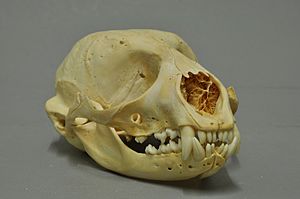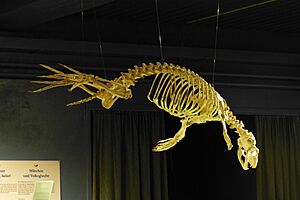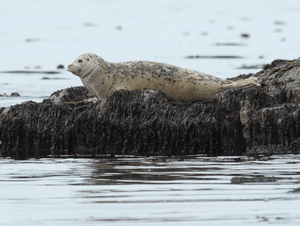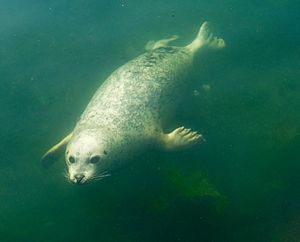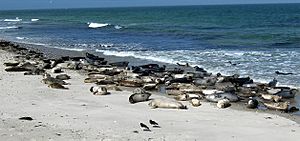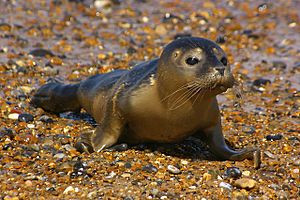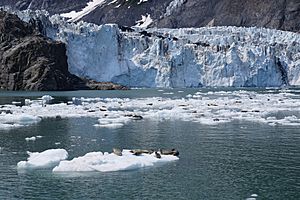Harbor seal facts for kids
Quick facts for kids Harbor (common) seal |
|
|---|---|
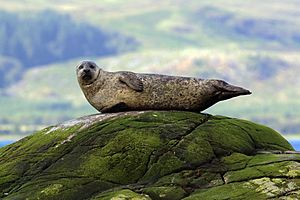 |
|
| A harbor seal off Lismore, Scotland | |
| Conservation status | |
| Scientific classification | |
| Genus: |
Phoca
|
| Species: |
vitulina
|
| Subspecies | |
|
P. vitulina concolor (DeKay, 1842) |
|
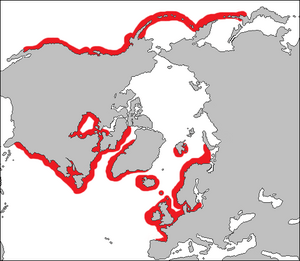 |
|
| Range of Phoca vitulina | |
The harbor seal (Phoca vitulina), also called the common seal, is a type of true seal. You can find them along the coasts of the Northern Hemisphere. They live in both cool and Arctic waters.
Harbor seals are the most widespread type of pinniped. Pinnipeds are marine mammals like walruses, eared seals, and true seals. These seals live in coastal waters of the northern Atlantic, Pacific Oceans, Baltic, and North Seas.
Harbor seals can be brown, silvery white, tan, or gray. They have unique V-shaped nostrils. An adult seal can grow up to 1.85 meters (6.1 feet) long. They can weigh up to 168 kilograms (370 pounds). A layer of blubber under their skin helps them stay warm. Female seals usually live longer than males. Females live about 30–35 years, while males live 20–25 years.
Harbor seals like to stay in familiar resting spots. These spots are often rocky areas, but can also be ice, sand, or mud. They choose places that protect them from bad weather and predators. These spots are usually close to where they find food. Males might fight over mates in the water and on land. Females have one pup after being pregnant for nine months. They care for the pup by themselves. Pups can weigh up to 16 kilograms (35 pounds) at birth. They can swim and dive just hours after they are born. Pups grow fast on their mother's rich milk. They stop drinking milk after four to six weeks.
There are about 350,000 to 500,000 harbor seals worldwide. However, one group, the Ungava Seal in Northern Quebec, is endangered. Hunting seals used to be common. Now, it is against the law in many countries where these animals live.
Contents
What Do Harbor Seals Look Like?
Each harbor seal has its own special pattern of spots. These spots can be dark on a light background or light on a dark background. Their color can range from brownish-black to tan or gray. Their undersides are usually lighter. They have short bodies and flippers, and rounded heads. Their nostrils look like a distinct V-shape.
Like other true seals, they do not have an outer ear flap (called a pinna). You might see an ear canal behind their eye. Including their head and flippers, adult seals can be up to 1.85 meters (6.1 feet) long. They can weigh from 55 to 168 kilograms (120 to 370 pounds). Females are usually a bit smaller than males.
Harbor Seal Populations
There are an estimated 350,000 to 500,000 harbor seals around the world. Overall, the population is not in danger. However, some groups, like those in Greenland, Hokkaidō, and the Baltic Sea, are exceptions. Some local groups have become smaller or disappeared. This can happen because of diseases, like the phocine distemper virus. It can also happen due to problems with humans.
In some places, like Norway and Canada, it is legal to hunt seals if they are thought to harm fisheries. But commercial hunting (hunting for profit) is illegal. Seals are also hunted for food by some groups. Sometimes, they are accidentally caught in fishing nets, which is called bycatch. Along the coast of Norway, bycatch caused 48% of pup deaths. In the United Kingdom, it has been illegal to kill or take seals since March 1, 2021.
In the United Kingdom, seals are protected by the 1970 Conservation of Seals Act. This law stops most ways of killing them. In the United States, the Marine Mammal Protection Act of 1972 protects all marine mammals. This law tells people to leave seals alone unless they are in serious danger.
Types of Harbor Seals (Subspecies)
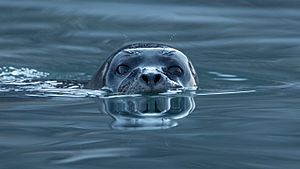
Scientists have identified five main types, or subspecies, of Phoca vitulina:
| Image | Subspecies | Common Name | Where They Live |
|---|---|---|---|
 |
P. v. vitulina (L., 1758) | Eastern Atlantic common seals | Europe and western Asia. |
 |
P. v. concolor (DeKay, 1842) | Western Atlantic common seals | Eastern North America. |
| P. v. mellonae (Doutt, 1942) | Ungava seals (Lacs des Loups Marins seals) | Found in fresh water in eastern Canada. | |
 |
P. v. richardsi (Gray, 1864) | Pacific common seals | Western North America. |
 |
Phoca vitulina stejnegeri (J. A. Allen, 1902) | Insular seals | Eastern Asia. |
Harbor Seal Habitat and Diet
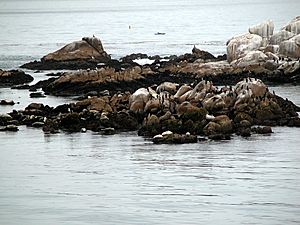
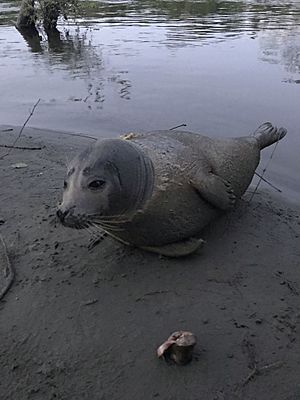
Harbor seals like to visit the same resting spots often. They might spend several days at sea. They can travel up to 50 kilometers (31 miles) to find food. They also swim far upstream into large rivers. They do this to find fish that migrate, like shad and salmon.
Their resting spots can be rugged, rocky coasts, or sandy beaches. Harbor seals often gather in harbors, bays, and estuaries. They hunt for fish like salmon, menhaden, anchovy, sea bass, herring, mackerel, cod, and flatfish. Sometimes, they also eat shrimp, crabs, mollusks, and squid. Even though they mostly stay near the coast, some seals have been seen diving over 500 meters (1,640 feet) deep. Harbor seals have also been known to attack and eat different kinds of ducks.
Harbor Seal Behavior and Life Cycle
Harbor seals are usually solitary animals. But they do gather together when they rest on land or during the breeding season. They don't form huge groups like some other seals. When they are not eating, they come onto land to rest. This is called hauling out. They usually stay close to the coast, not going more than 20 kilometers (12 miles) offshore.
Females give birth once a year. They are pregnant for about nine months. Both courtship and mating happen underwater. Researchers have seen male seals gather underwater. They turn on their backs, put their heads together, and make sounds. They do this to attract females ready to breed. Females can have pups from age 3 to about 36.
Pups are born on shore each year. The time of year they are born depends on where the seals live. It can be as early as February in warmer places or as late as July in colder areas. Only the mothers care for the pups. They feed them milk for about 24 days. Pups are born well-developed. They can swim and dive within hours of birth. They drink their mother's rich, fatty milk and grow quickly. Pups are born weighing up to 16 kilograms (35 pounds). They can double their weight by the time they stop drinking milk.
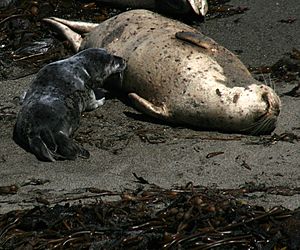
Harbor seals need to spend a lot of time on shore when they are molting. Molting is when they shed their old fur, and it happens shortly after breeding. This time on land is very important for their life cycle. It can be disturbed if there are too many humans nearby. The time when they start molting depends on their age and sex. Younger seals molt first, and adult males molt last. A female mates again right after her pup stops drinking milk. Harbor seals sometimes don't want to come ashore if humans are around. So, building near the coast must be carefully planned in areas where seals are known to rest.
Compared to many other seals, harbor seals are usually quieter. However, they do use sounds to mark their breeding areas. They also use sounds to attract mates at certain times of the year. Mothers and pups also use sounds to communicate.
Adult male seals have about a 91% chance of surviving each year. Adult females have about a 90.2% chance. Females can live up to 36 years, and males up to 31 years.
Harbor Seals in North America
Pacific Coast Seals
The harbor seal population in California was about 25,000 in 1984. These Pacific harbor seals live along the entire Pacific Coast of California. They like to stay close to shore in shallow waters. They are not seen far out in the open ocean. They often go into bays, estuaries, and even swim up coastal rivers. They eat fish like herring, flounder, hake, anchovy, codfish, and sculpin.
Breeding in California happens from March to May. Pups are born between April and May, depending on the local group. Harbor seals are important predators in the kelp forest. They help keep the ocean healthy. killer whales (orcas) and white sharks hunt them.
You can see seals resting on urban beaches in California. They sometimes nap on beaches in San Francisco Bay, including areas near Richmond, Oakland, and San Francisco. They are also seen in the Greater Los Angeles area, like Santa Barbara, Los Angeles, and Long Beach. And they are famous at beaches near La Jolla in San Diego Bay.
Scientists have studied diseases in harbor seals since the 1980s. This includes studying viruses like phocine herpesvirus. In San Francisco Bay, some harbor seals have reddish fur. This might be from metals like iron or selenium in the ocean. Or it could be a change in their hair.
Some of the biggest areas where harbor seal pups are born are in California. But they are also found north along the Pacific Coast in Oregon, Washington, British Columbia, and Alaska. Large groups of seals move south with the seasons along the west coast of Canada. They might spend winter on islands in Washington and Oregon. Pups are known to be born in Washington and Oregon as of 2020. People are told to stay at least 50 meters (164 feet) away from seals resting on land. This is especially important for pups. Mothers might leave their pups if there is too much human activity nearby.
Atlantic Coast Seals
Long ago, harbor seals lived from the St. Lawrence River and Greenland all the way to North Carolina. This was a distance of over 1,600 kilometers (1,000 miles). We know this from old records and place names. For example, Robbin's Reef, near Bayonne, New Jersey, gets its name from the Dutch word robben, meaning "seals." Machias Seal Island, on the border of Canada and the US, is now a bird sanctuary. Seals visit there sometimes.
Over hundreds of years, seals were hunted a lot. Fishermen shot them, and pollution also harmed them. Old documents from New England show that people were paid to hunt seals. Accounts from harbor masters also tell this story. When New York City was founded in the 1640s, it was built on a huge estuary full of life, including harbor seals.
In the 1800s, oil started polluting the water. Then, in the 20th century, even more toxic chemicals like PCBs and dioxin were added. By the time of the Clean Water Act in 1972, New York Harbor was almost dead. Almost nothing could live there. About 300 miles north, Boston Harbor was also very polluted. Raw sewage had been dumped there since the late 1800s. The smell from the Charles River was very strong. Fish in the area had large tumors by the 1980s. The harbor seal had been hunted away.
But as of 2020, the seals have returned! They never completely disappeared from Canada and parts of the Maine coast. These areas became important places for the seals to grow their population again. From there, they could return to their old homes. Now, they are regularly seen as far south as the barrier islands of North Carolina. Massachusetts is the southernmost place where pups are known to be born along the Atlantic Coast.
Harbor seals move south from eastern Canadian waters to breed. They go to the coast of Maine, Cape Cod, and the South Shore in Massachusetts in May and June. They return north in the fall. Other seals, especially young ones, travel south to warmer waters for a "vacation." They do this because they can't compete with adult seals for food and space. They don't go back north until spring.
A park ranger in New York City says, "New York is like their Miami resort." This means young seals from Cape Cod and even the Arctic come to the harbor in winter. In 2018, the New York Post reported that the harbor is "cleaner than it has been in 110 years." Since the early 2000s, harbor seals have found their old home to be a place with plenty of food and clean water.
You can see groups of harbor seals near the New York skyline. They are found on Hoffman and Swinburne Islands. They also use parts of Red Hook and Staten Island. They come ashore there from October until early May. Their favorite foods are also returning to New York Harbor and nearby New Jersey. Schools of mossbunker now attract harbor seals, their cousins the grey seals, dolphins, and even whales. Both the northern and southern shores of Long Island have many harbor seals and grey seals. They eat sand lance and some types of crabs there.
See also
 In Spanish: Foca común para niños
In Spanish: Foca común para niños



